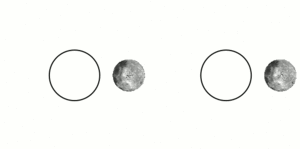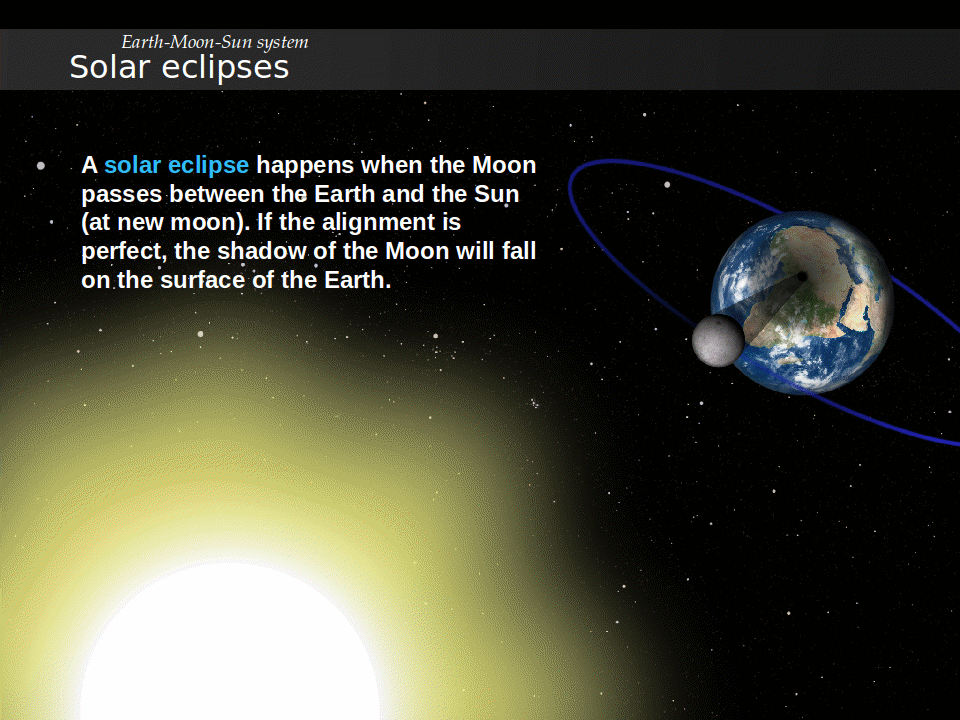Science about the Moon
Earth-Moon system – Studying the change in earth-moon distance
Scientists can determine the distance Earth-Moon with great precision by bouncing a laser beam on special mirrors deposited on the Moon ́s surface by astronauts in 1969, and measuring the round travel time of the light. They have directly measured that the Moon is slowly receding from the Earth at a rate of 2.14 cm/year . That is, the Earth-Moon distance is increasing with time. This is happening because tidal torques on the Earth are transferring angular momentum to the Moon
They have directly measured that the Moon is slowly receding from the Earth at a rate of 2.14 cm/year . That is, the Earth-Moon distance is increasing with time. This is happening because tidal torques on the Earth are transferring angular momentum to the Moon
- Earth-moon rotational dynamics
- Evolution of the System – “The Big Thwack”
- Was the moon tidally locked initially?… what are the implications
Earth-Moon Rotational Dynamics – Tidal Locking of Earth Moon System:
Tidal locking: Lunar orbital Period = Period of Lunar revolution about lunar axis:
- Left: (Except for libration effects), Moon keeps the same face turned toward Earth
- If the Moon were not rotating at all, it would alternately show its near and far sides to Earth, while moving around Earth in orbit (picture at right).
– courtesy “Wikipedia Tidal Locking”
Conservation of Angular Momentum
The gravitational torque between the Moon and the tidal bulge of Earth causes
the Moon to be constantly promoted to a slightly higher orbit and Earth to be
decelerated in its rotation.
Total energy and angular momentum are conserved.
- Energy and angular momentum are transferred from the rotation of Earth to the orbital motion of the Moon
- However, most of the energy lost by Earth is converted to heat by frictional losses in the oceans and their interaction with the solid Earth, and only about 1/30th is transferred to the Moon).
- The Moon moves farther away from Earth (+2.17 cm/y) in order to maintain conservation of angular momentum
– courtesy Wiki article on Tidal Acceleration
Reason for Increasing Lunar Orbit
Earth’s tidal bulges make opposite torques on the moon, and these torques don’t exactly cancel. The lack of cancellation is because friction causes the bulges to be misaligned with the earth-moon axis, and also because the bulges are at unequal distances from the moon, as explained by the following diagram:
As the moon moves in its orbit, the bulge of the tides leads a little bit (because of drag on the earth’s surface). Consequently, the bulge that is closer (and thus has a stronger force on the moon) is slowing the moon down a little bit; this force is not completely canceled out by the “leading” bulge on the other side, which is further away and therefore provides a weaker force.
This results in the dotted vertical arrow (net force), which shows the moon’s orbital trajectory. This resultant allows the moon to drift to a larger radial trajectory .
– courtesy ” courtesy physics stack exchange: conservation of Angular Momentum>
The Big Thwack – Early Earth-Moon System Formation
In Earth history, one single event .. one day more memorable than any other. About 4.5 billion years ago, when the Solar System was about 50 million years old, the black proto-Earth and a slightly smaller planet-size competitor were jockeying for the same narrow band of Solar System real estate. The smaller would-be planet (dubbed Theia, after the Titan goddess who gave birth to the Moon) was worthy of planetary status perhaps two to three times the size of Mars (or roughly a third of Earth’s mass). A rule of astrophysics is that no two planets can share the same orbit. Eventually they will collide, and the larger planet always wins. So it was with Earth and Theia.
Computer simulations provide the principal method by which scientists attempt to understand what might have happened. A big collision is governed by the laws of physics, so one can run thousands of simulations with all sorts of initial conditions to see if a Moon results. The answer is intimately tied to the starting parameters: the mass and composition of the proto-Earth, the mass and composition of Theia, their relative velocities, and the angle and accuracy of the blow.
Theia was roughly 40 percent the mass of the proto-Earth. Again, an off-center impact occurred, but in this version, Theia more or less bumped against Earth and bounced off as an elongated blob, then was pulled back in for the coup de grace .. a second thwack, in which Theia disappeared forever. In either case, the catastrophe annihilated Theia, which simply vaporized into an immense incandescent cloud, tens of thousands of degrees hot, surrounding Earth. Not all of Theia was captured, however. Higher up in space, Earth became encircled by a vast accumulation of rocky collisional debris, mostly an intimate mixture of the two planetary mantles. Cooling rocky droplets stuck together, with bigger chunks sweeping up the smaller. In a sort of instant replay of the gravitational clumping that originally formed the planets, the Moon coalesced rapidly and may have achieved more or less its present size in a few years.
The physics of planet formation dictate where the Moon could have formed. Every massive object has an invisible surrounding sphere, called the Roche limit, inside of which gravitational forces are too great for a satellite to form. That’s why Saturn has immense rings but no moons within about fifty thousand miles of its surface.Calculated from the center of a rotating object, Earth’s Roche limit is about 11,000 miles, or roughly 7,000 miles up from the surface. See wiki article – Roche limit
Accordingly, models of Moon formation locate the new satellite at a safe distance of about 15,000 miles up, where it could grow in an orderly fashion by sweeping up most of the scattered bits and pieces from the Big Thwack. And so, perhaps 4.5 billion years ago by most estimates, the Moon was born. Earth found itself with a companion, formed in large part from pieces of itself.
Original Distance, Lunar Orbit and Earth Spin
4.5 billion years ago, things were very different. With the Moon only 15,000 miles away, everything was turning ridiculously fast, like the ice-skater who pulls in [his] arms to speed up [his] spin.
For one thing, Earth rotated on its axis once every five hours. It still took a full year (about 8,766 hours) to go around the Sun; that time hasnt changed much in the history of the Solar System But ancient fossil corals from the Devonian Period, about four hundred million years ago, display more than four hundred daily lines per year, pointing to a faster rotation rate. Days were only about twenty-two hours long back then, when the Moon was perhaps ten thousand miles closer to Earth.
The total amount of spinning energy of the Earth-Moon system – its angular momentum is measured by a combination of two familiar circular motions. First is Earths rotation about its axis; the faster Earth rotates, the more angular momentum it has. The Moons angular momentum, by contrast, depends primarily on how far away and how fast it orbits around Earth. Its own rotation is not a significant part of the equation.
The total angular momentum of Earth’s rotation plus the Moon’s orbit hasn’t changed significantly over the last several billion years, but the relative importance of those two motions has changed a lot. Today almost all the angular momentum of the Earth-Moon system is tied up in the orbiting Moon, with its 239,000-mile distance and twenty-nine-day orbital period. These epic tidal disruptions lie at the heart of why the Moon keeps moving away from Earth. How does a 2,160-mile-wide object drift from a mere 15,000 miles to 239,000 miles away? The answer is found in the conservation of angular momentum the constant sum of Earths rotational energy plus the Moons orbital energy. The laws of physics dictate that whatever angular momentum the Earth-Moon system had at its origin, it must still possess in large measure today
.
Summary
- Tidal Locking of the satellite – Moon into the Earth Moon System – after the Big Thwack
- Earth-Moon distance The Moons orbit is increasing: – the moon’s orbit is increasing in size as it moves away from the earth at a rate of 4 cm/year or 4km/10,000 years. However at the time of formation of the earth-moon system, the moon was only 3 to 5x the Earth radius in distance – sufficiently far enough to be outside of the Roche Limit.
The Moon’s gravity produces tidal deformations or bulges in the Earth. - Dynamics of change – The Earth’s spin speed is decreasing so its spin angular momentum is DEcreasing. Therefore, the Moon’s orbital angular momentum must compensate by INcreasing. It does this by increasing the Earth-Moon distance.
- Cause: Because of the Earths rotation, the line that goes through the bulges is not aligned with the line between the Earth and the Moon. This misalignment produces a torque that transfers angular momentum from the Earth’s rotation to the Moon’sorbital translation. There is a consistent Torque on the satellite pushing it into a higher orbit
- Effect: Corresponding slowdown of the primary’s rotation See Description of the Earth Moon case – Tidal Acceleration Wikipedia
- Implications – final transfer of momentum – locking of Primary (Earth)
Implications
This process of transfer of angular momentum will end when the period of rotation of the Earth and the period of revolution of the Moon around the Earth have the same duration. At this point the tidal bulges produced by the Moon on the Earth will be aligned with the line between the Moon and the Earth and the torque will disappear.
The present distance between the earth and the moon is 384,000km.
The final distance at which the Earth will also be locked such that the day on earth (the period of revolution) will be the same as the period of rotation of the earth is calculated to be about 540,000 kms (1.4x).
At this time, a day on earth will amount to 46 current days.
-courtesy Evolution of the Earth-Moon System – Calculations and Detailed calculations
Take a tour with the LRO satellite of our satellite:
See LRO’s (Lunar Reconnaissance Orbiter) Tour of the Moon
Understanding Earth-Moon Interactions
- Eclipse – Solar (new Moon) and Lunar (full Moon)
- Tides
- Libration
Solar Eclipse – When Moon eclipses the Sun. This is a Daytime event and happens at New Moon. (Moon is in the daytime sky). The Earth-Moon-Sun are in alignment so that the Moon (just the right distance to produce angular coverage) covers part of or all of the Sun’s disk when viewed from Earth
Slides courtesy Julie Bolduc-Duval fromCanadian Astronomy program:Discover the universe
Lunar Eclipse (Earth between Sun and Moon) – at Full Moon.The Moon is being eclipsed by the Earth.
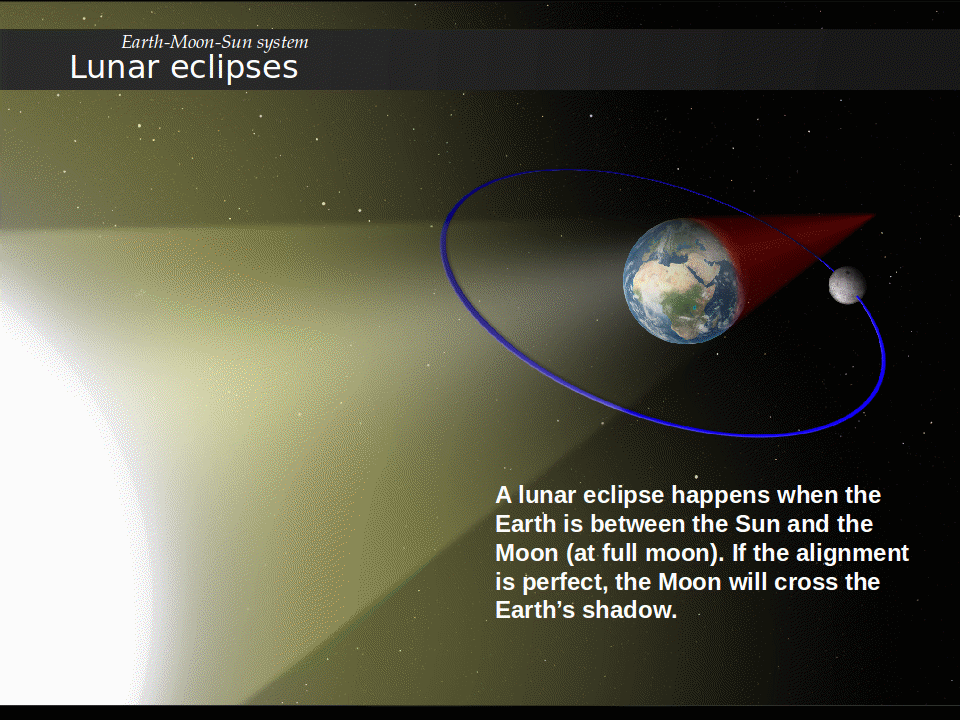
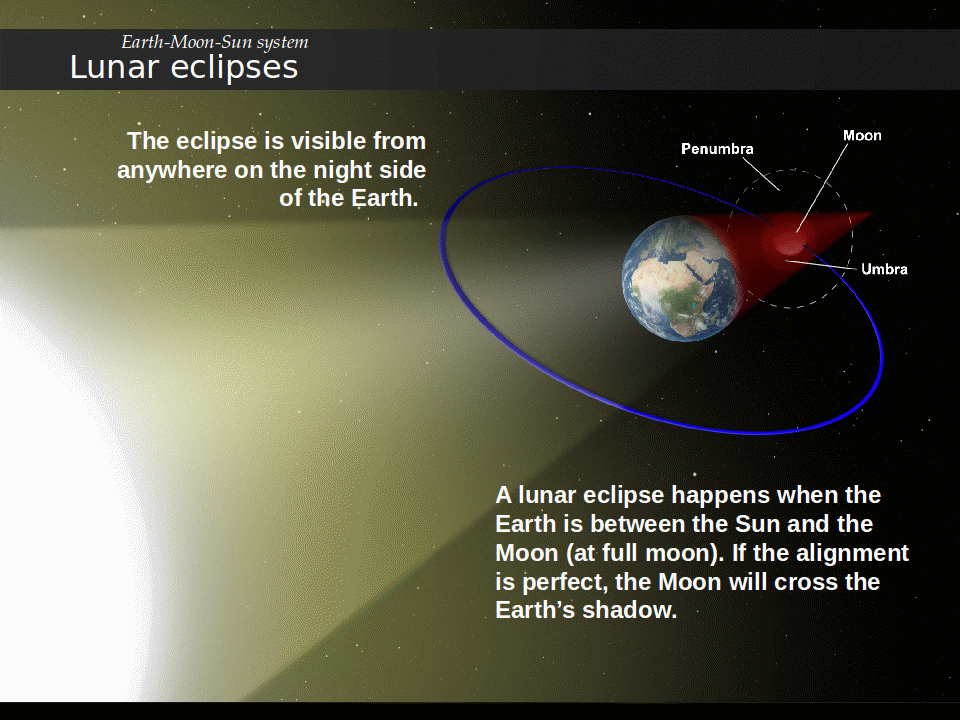 For example on Monday/Tuesday April 2014 the moon is above our horizon for the entire total Lunar eclipse . Here are the timing details from the Observers Handbook 2014 of the RASC.
For example on Monday/Tuesday April 2014 the moon is above our horizon for the entire total Lunar eclipse . Here are the timing details from the Observers Handbook 2014 of the RASC.
Data Courtesy Royal Astronomical Society of Canada, Observers Handbook 2014
Since Lunar Eclipses happen at Full Moon, we get a chance to observe certain features
- The Ray Craters – radial streaks of fine ejecta thrown out during the formation of impact crater”
- Maria – vast expanses of solidified lava
- Slight hints of the terminator – (the line between shadow and light at the lunar limb). The Moon is rarely “full” in the sense that it appears 100% illuminated – face on to earth.
- Libration
Due to the effect of lunar libration where the moon is tilted towards us on one side, we will see some shadow on the other side.
Tides –How do the Tides Effect the Earth:
Tidal forces are responsible for the two bulges of water on opposite sides of the earth. These two tidal bulges are produced, one on one side of the Earth and one on the side facing away from the moon. Because the moon is quite far from the Earth (about 60 Earth radii), the two tidal bulges are essentially equal in size . The moon yanks the water and moon on the near side; the moon yanks Earth out from under the waters on the far side!… leaving these waters behind
Courtesy Roy Bishop , RASC Observers Handbook

Newtonian Tides
Generally, In the Universe, tides are a result of the gravitational effect between two bodies. This can happen between stars and even galaxies. As Roy Bishop points in Tides and the Earth-Moon system, Newton’s theory of gravitation in unwarped Euclidean space is more ‘than adequate for describing the ‘gentle tides’ on Earth to high accuracy”.
Differential Tidal force in the Earth-Moon system is outlined below:
- Newton’s Principia (1687) Difference in the force of gravity – One side of the attracted body to the other side. (Difference in force from the side closest to the gravitational line of force to the side furthest away from the graviational line of force)
- The decrease of the force of gravity with distance causes the tides. The moon exerts a force on the Earth and the Earth responds by accelerating toward the Moon.
- However the waters on the hemisphere facing the Moon, being closer than the waters on the opposite hemisphere accelerate more and fall ahead of the earth. Similarly the Earth itself accelerates more than the waters on the other hemisphere and falls ahead of these waters.
The Differential Gravity Forces
The near point A is being pulled toward the Moon relative to the centre point C. Similarly point C at the center of Mass is also pulled toward Moon, The far point B is pulled away from the Earth because of the total difference in forces on A, C and B. The difference between these (vector) forces is the tidal force.
The Differential Force DF (differentiate Newton’s Law of Gravitation)
dF/dR (GMm/R^2) = (-2GMm/R^3)
where DF is the differential gravitational Force directed along R (the distance between the two bodies). As the distance between the two bodies decreases, the tidal force decreases. As the combined Mass increases, the tidal force increases.
General Relativity and Tides – Gravity Warps Space (Kip Thorne)
We inhabit an Einsteinian universe, a universe in which gravitation is a manifestation of spacetime, as we observed in Sept 2015 See- Millstonenews –Observing a storm in the fabric of spacetime.
Again, quoting Roy Bishop: “The Moon’s mass alters the structure of spacetime at its location and this propagates outward, becoming more dilute with the volume encompassed according to the cube of the distance [see above]. At Earth, the distortion results in the waters of the oceans following slightly different path through spacetime [tendex (like spandex) lines of Kip Thorne’s formulation] than does the rigid planet beneath, producing the characteristic egglike shape of the tidal effect: [below Thorne’s stretching and squeezing properties caused by Gravity Warping Space]. This diagram below is taken from Kip Thorne’s Chapter 4 Warped Time and Space and Tidal Gravity – subsection on Gravity Warps Space. The Einsteinian explanation is different, but the calculations using the field equation of general relativity agree with the Newtonian… Kip Thorne’s book, The Science of Interstellar discusses tidal forces:
Einsteinian: The Tidal forces are produced by blue tendex lines that squeeze the Earth’s lateral sides and red tendex lines that stretch towards and away from the Moon. This is just like a black hole’s tendex lines . The Moon’s tendex lines are visual embodiments of warping of space and time.
Earth Moon Interaction: 1 Lunar Revolution ~ 1 Lunar Axis Rotation
Astronomers who have studied the moon for centuries felt frustrated that they could see only one side! The moon turns on its axis in exactly the same time period that it takes to go around the earth, 27.3days. It rotates slowly 13 degs per day as well as travels slowly at 13 deg/day so it keeps the same side always toward the earth (but not toward the sun). This synchronous rotation of the moon around the earth is the result of a tidal locking of the moon to the earth. Torques (twisting forces ) are applied to the moon which slow down the rotation and keep it aligned, pointing to the major axis of the earth-moon system
See http://en.wikipedia.org/wiki/Tidal_locking#Earth.27s_Moon
Standard names for Phases of the Moon
New Moon – The moon is not (or just barely) visible in the evening sky. It is the period when the moon rises and sets with the sun (roughly).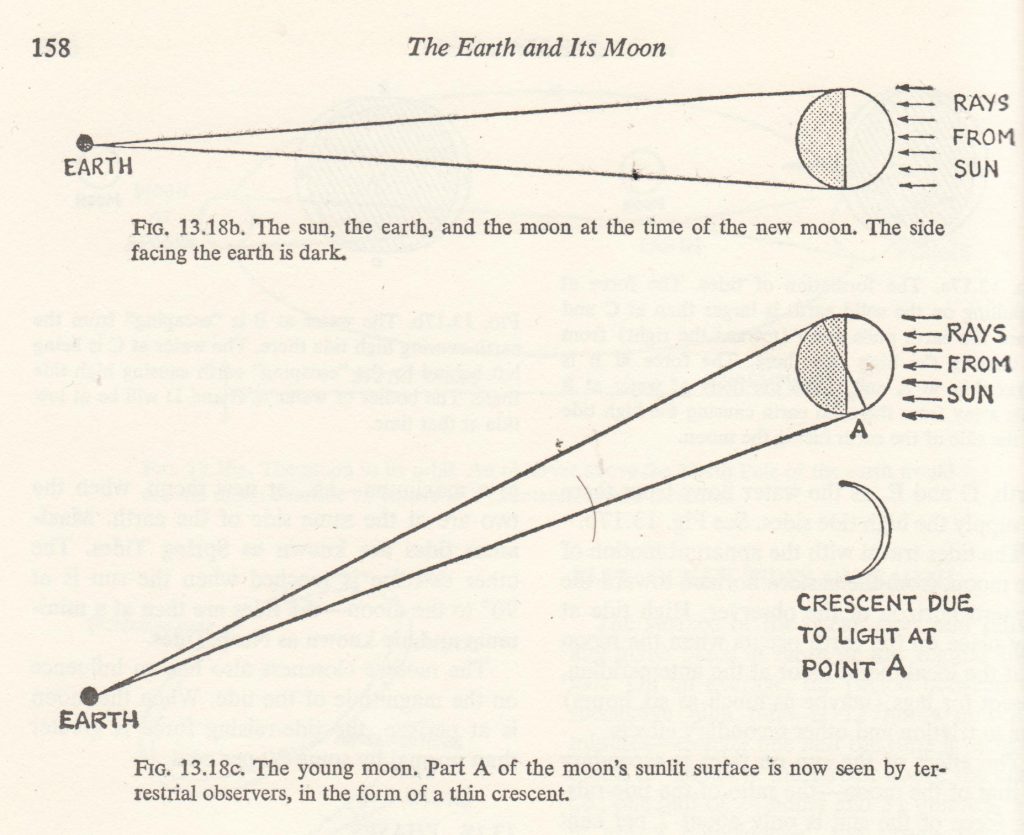
This is the time to observe Deep Sky objects (such as objects in the Messier Catalog – which include stellar nebulae, Open Clusters, Globular Clusters and Galaxies).
First Quarter – One week after new moon (the first quarter of the 4 quarters of the lunar cycle), the moon appears in the night sky, and sets after midnight. It is said to be ‘waxing’ or growing. It is roughly 50% illuminated. Deep Sky objects are hard to see. This is a good time to view the features of the moon near the terminator where light and shadow are apparent. (More on that later)
 “First Quarter” Simulation: Sun-Moon-Earth angle of 90 deg illustrates Moon ‘sphere’ 1/2 lit
“First Quarter” Simulation: Sun-Moon-Earth angle of 90 deg illustrates Moon ‘sphere’ 1/2 lit
Full Moon – One week later (2 weeks after New Moon) we see the fully illuminated moon, and not much of the deep sky! The moon appears like a flat disk. Shadows have fled, and the bright, washed out appearance is good for a going for a walk in the moonlight.
Third Quarter – The moon is said to be ‘waning’ . Again, a good time to see the features on the moon.
At Full Moon there are no Shadows to Observe
Features remain in darkness and gradually become illuminated from 0-14 ‘day-old’ moon For these features and more, one of the best ways to make a project study out of the moon is to observe with the Royal Astronomical Society of Canada’s (RASC) Isabel Williamson Lunar guide. This is the guidebook we use to work on the RASC Lunar Certificate program.
For more discussion on the lunar guide See Lunar Observing and the Isabel Williamson Lunar Guide (Millstone News article)



